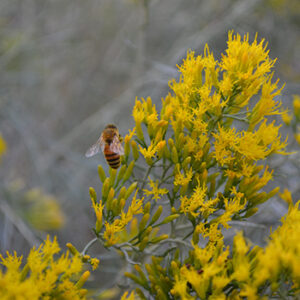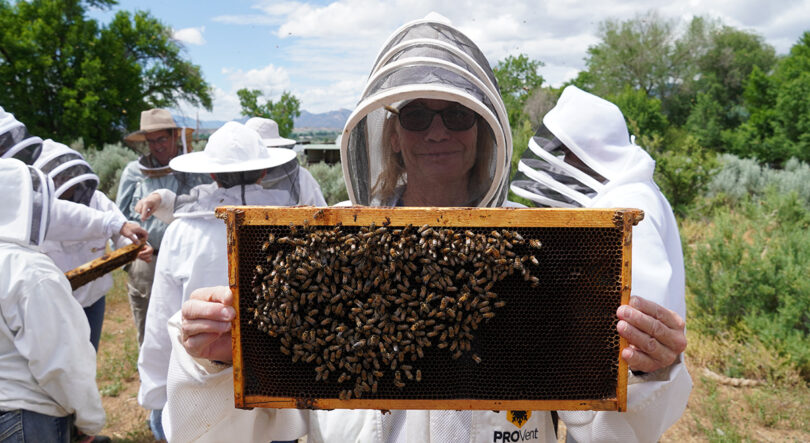By Joanne Palmer
Ed Colby, 76, is about to attempt to grow a bee beard for the grand finale of Bee College. He gamely strips off his shirt and walks into a cluster of pastel-colored hives. It’s hard not to think of a gladiator entering the ring as the other students cheer him on: “Make sure the zipper of your pants is pulled up,” one person calls with an encouraging laugh.
Undaunted, Colby bravely takes a seat on one of the hives. A small cage about the size of a thumb is attached by a string to his chin. The queen bee is inside. Master beekeeper Tina Sebestyen from Bayfield shakes a frame full of honeybees, and the ever-loyal bees begin to buzz around Colby in search of their queen. Colby is statue-still. As past president of the Colorado Beekeepers Organization and a beekeeper for 28 years in the New Castle area, he knows that sudden movements startle bees and the best way not to get stung is to remain motionless. While waiting, Colby confesses, “I can’t grow a real beard anyway.”
Although Colby isn’t wearing a shirt, he has taken some preventive measures. He has spread Vaseline to ban honeybees from inside his ears and nose. Hundreds of bees fill the air with their distinctive hum, and the sound is oddly pleasing. Sebestyen shakes a few more frames to release more bees, and after about 20 minutes, Colby sports more of a bee necklace than a beard, but no one is complaining. It’s still a great show.

Bee on Rabbit Brush. Photo by Sue Keefer,
an SECPA member
Bee College, organized by the Colorado State Beekeepers Association, is an annual event for beekeepers. Held in Rifle, participants spend the morning listening and learning from master beekeepers and entomologists, then head into a nearby field for hands-on activities.
All in at Bee College, I donned a bee suit for the first time and was quite pleased. It was lightweight and roomy enough to hide all figure flaws. Pulling up the hood can salvage any bad hair day (which for me is always a plus). Feeling like a cross between an astronaut and an oversized marshmallow, I marched into the field for a demonstration and immediately committed a rookie move by blocking the entrance to one of the hives. “Don’t stand in front of the door,” someone admonishes me. Afraid of being stung, I jump back but, Duh! I’m wearing protective gear.
Taking a big breath, I reposition myself to the side of the hive and watch as Sebestyen opens the top. Inside the hive are eight frames, seven full of honeybees and one feeding frame, filled with sugar water. It looks like a filing cabinet. To calm the bees, Sebestyen picks up a silver smoker and sprays a small puff of smoke into the hive. (The smoke beekeepers use comes from burning a variety of natural fuels, such as twigs or burlap.) Once the bees are calm, Sebestyen expertly pries out a frame using a special tool that looks like a putty knife with a hook on the end. Suddenly, we all stare at hundreds of bees.
Here’s the hive make-up: one queen, hundreds of drones, and thousands of worker bees. The male drones don’t sting; their only purpose is to breed. Although that might sound like a sort of bacchanal heaven, after mating (in mid-air, mind you), they fall to the ground and die. The worker bees are all females and do the heavy lifting: moving pollen from flower to flower and bringing nectar back to the hive.
The other attendees “Oooh” and “Ahhh” over the scurrying bees and say intelligent-sounding things like, “Look at the brood pattern,” and “Do you see the beautiful pollen over there?” Meanwhile, I am having more of a Where’s Waldo? moment. All the honeybees look alike to me. But I’m determined to learn. Sebestyen pulls out one frame after another in search of the queen. She is the boss-babe, the CEO of the colony. According to beekeeper Therese Beck, “The queen dictates the temperament of the hive according to her personality. It can be territorial, aggressive, gentle, defensive, or reactive.”
A queen’s primary job is to lay eggs — she can lay between 1,500–2,000 eggs per day. But along with that comes the royal treatment — attendants feed, groom, and carry away her waste. Not too shabby. I’m anxious to get a look at her. And finally, in the last frame, there she is. Sebestyen expertly plucks her out by the wings and quickly dabs a white dot on her back to denote her age and make her easier to find.

Bee on a Flower.
Photo by Lexee Maestas, a PVREA member
Spending a day with beekeepers is like visiting a foreign country —beekeepers definitely have their own lingo. Bee-speak includes words such as “pheromones,” “propolis,” and “thermoregulation.” In case you need a brush-up on basic science and the importance of pollination, just remember approximately one-third of the food we eat depends on honeybees for pollination. According to USDA-National Agricultural Statistics Service, honeybees pollinate $15 billion worth of crops in the United States each year, including more than 130 types of fruits, nuts, and vegetables. Thank a bee the next time you bite into an apple, cherry, or almond.
Somewhat confused by the terminology and which bees are doing what, I opted for a one-on-one private tutorial. Fortunately, I found a willing coach in Derrick Maness, who runs Mountain Bee Honey, a commercial operation with 3,000 hives spread out across the state including Meeker, Craig, and even Trapper’s Lake. Maness has been working with bees for more than 20 years and still remains in awe of these industrious insects. “Every day I learn something new. It’s magic. Pure magic,” he says. He patiently explains the life cycle of a bee, and I’m intrigued to learn the age of the bee dictates her job. “When a baby honeybee hatches, she is a nursery bee, then a cell and wax builder, then a guard bee and finally a forager,” Maness says. “The guard honeybee patrols the entrance of the hive. She produces pheromones, which act as a kind of signaling device to other bees: ‘Hey, here’s home.’ She also acts as a sentry or bouncer, keeping out unwanted visitors, like wasps.”
The expression, “Busy as a bee,” is no joke. Bees literally work themselves to death and never stop producing honey. But where’s the honey? Maness explains we’re looking at brood boxes, the spot that bees will call home through the winter. As the bees fill up those boxes with honey, more boxes — or “supers” — are added on that will eventually be harvested.
During a break, I’m surprised to hear other beekeepers describe beekeeping as “meditative.” Who would think having hundreds of honeybees flying around your head with the ability to sting you would be relaxing? But apparently it is. As beekeeper Matt McLean puts it, “Beekeeping is a meditative practice that forces you to go slow, move slower, breathe slower. You have to be present and nowhere else but right here in the hive, mentally and physically.” Therese Beck agrees: “Honeybees calm me down. Going at a bee pace, which is pretty slow, relaxes me.”
Beekeeping is a meditative practice that forces you to go slow, move slower, breathe slower. You have to be present and nowhere else but right here in the hive, mentally and physically.”
—Beekeeper Matt McLean
Honeybees may move in slow-mo until they decide it’s time to dance. Yes, dance! Honeybees don’t have ears, so one of the ways they communicate is by busting a move. Breaking news in the honeybee world might be the discovery of a field of dandelions: Yellow flowers full of yummy nectar. But how do they let other honeybees know? They need to spread the good news to the thousands of their honeybee friends toiling in the dark. So, they do the Waggle Dance.
Becky Edmiston, professor of biology at Colorado Mountain College in Steamboat Springs, explains it like this: “They crawl up the frame and shake their bee bottoms — waggle, waggle, waggle. Then they run around and go right back in the same direction.”

Busy Bees. Photo by Judy Malarchick, an Empire Electric Association member.
Turns out the Waggle Dance is sophisticated communication. “The direction they waggle tells the other bees what direction to fly, and the length of the dance is how far they go,” Edmiston continues. “The longer the waggle, the further away the flower, and the direction they point is the direction of the flowers. When you hold up a frame with thousands of bees and they’re dancing, it’s incredible.”
Edmiston and her husband Dan started beekeeping in 2015 after receiving a small cash gift from Becky’s grandmother, Pollyann. “We call it Matriarch Honey and named the hives after our grandmothers: Pollyann, Ruby, and Louise. My grandmother is 92 and she’s always excited to hear about what’s going on with the honeybees,” Becky says.
Before you jump on the beekeeping bandwagon, know that the start-up costs are not cheap and the learning curve is steep. You’ll need roughly $1,000 for a suit, hives, and bees. And, as KT Thompson, treasurer of Colorado State Beekeepers Association and a beekeeper with hives in and around Brush, points out, “Bees are insects, not mammals. While it’s easy to tell if your dog needs food or a drink of water, bees are different.” To improve your chances of success, join a local beekeeping club and find a mentor. Sebestyen adds, “Perseverance is the key. Beekeeping is hard, and people who know that and are prepared to do what it takes will do well most of the time.”
Sadly, due to climate change, habitat loss and deadly mites the honeybee population is dwindling. But there are easy ways to help. Bees love flowers, especially dandelions in the spring and herbs (think lavender, sage, thyme); they need lots and lots of water to drink. A simple pot of pretty geraniums and a shallow dish of water can help our flying friends. Pesticides are bad news for bees; keep it chemical free.
At the end of the day my head is overflowing with information and I have a new appreciation for bees and beekeepers. Bee College helped me step outside of my comfort zone and into a beekeeping suit and taught me that I will leave the important work of beekeeping to the pros. It also taught me how critically important bees are — they sustain our way of life through pollination. By saving and protecting them we are doing something for the planet and for ourselves.
The last thing I do before getting into my car is pop into the self-serve Honey House right there on the property to pick up some honey. Who knows … it might inspire me to do a Waggle Dance once I get home.
Joanne Palmer lives with her partner and rescue dog on Colorado’s Western Slope. She has been a stringer for The Denver Post and published dozens of newspaper and magazine articles. She enjoys writing about the humor in being human from more personal experience than she’d care to admit.

